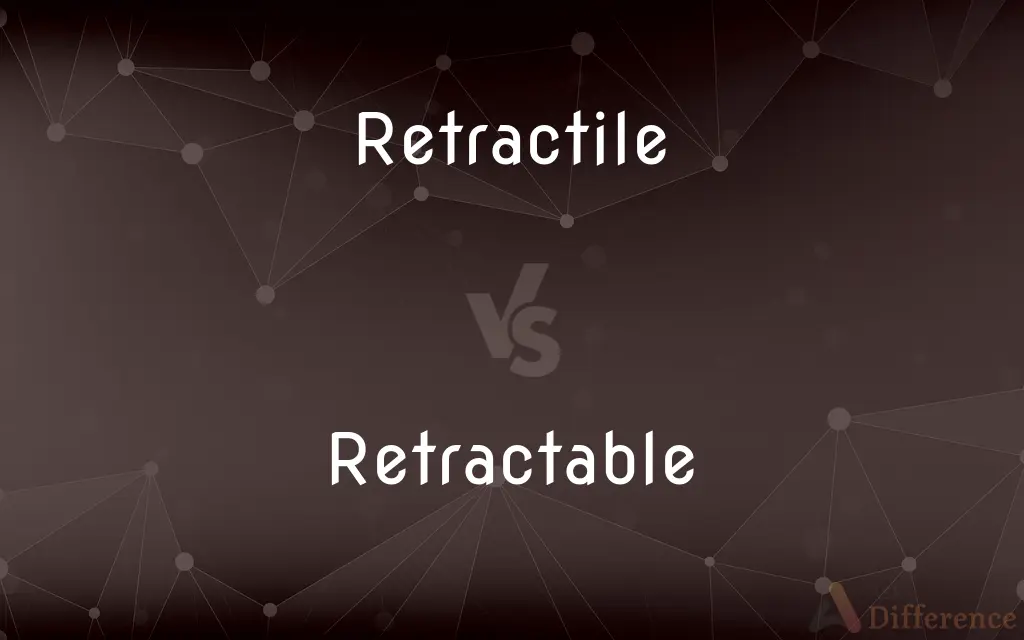Retractile vs. Retractable — What's the Difference?
Edited by Tayyaba Rehman — By Urooj Arif — Updated on April 16, 2024
Retractile claws naturally withdraw into an animal’s paws for protection, while retractable mechanisms in devices require manual or mechanical action to retract.

Difference Between Retractile and Retractable
Table of Contents
ADVERTISEMENT
Key Differences
Retractile features, such as the claws of a cat, are inherently designed to withdraw smoothly into the body, primarily for safety and to prevent wear. On the other hand, retractable elements, like a retractable pen tip, are engineered to be pulled back by a user or a mechanism.
A retractile attribute is typically biological, aiding in an animal's stealth and hunting capabilities, whereas retractable functions are often seen in technology and tools, enhancing usability and space efficiency.
Retractile parts operate based on natural instincts or anatomical structures, minimizing damage or exposure when not in use. Retractable components, however, utilize mechanical or electronic systems to achieve similar concealment or protection goals.
While retractile mechanisms are usually passive, requiring no energy input from the organism, retractable systems may need manual activation or power to function.
Retractile features enhance the survival and functionality of organisms by integrating seamlessly with their natural behavior. In contrast, retractable features are designed to contribute to the ergonomic and practical design of objects, often improving human interaction.
ADVERTISEMENT
Comparison Chart
Nature
Biological
Mechanical or electronic
Example
Cat claws
Retractable pen
Activation
Automatic, based on biological need
Manual or powered mechanism
Purpose
Protection, minimizing wear
Space-saving, convenience
Dependency
Relies on natural structure and instinct
Depends on user interaction or power
Compare with Definitions
Retractile
Naturally capable of being drawn back or in.
Many predators have retractile claws that help them catch their prey.
Retractable
Often found in gadgets and machinery.
Retractable leashes allow pet owners to control the length with a simple button.
Retractile
Biologically integrated retracting capability.
The retractile mechanism of some plant buds protects them from harsh weather conditions.
Retractable
Requires user interaction or power to operate.
Retractable landing gears are essential for the safety and efficiency of an aircraft.
Retractile
Able to retract without external apparatus.
The retractile nature of a snake's fangs allows it to prevent injury during non-use.
Retractable
Capable of being drawn back through mechanical means.
Retractable roofs on stadiums can open or close depending on weather conditions.
Retractile
Drawn in by natural mechanism.
Retractile antennae help insects avoid damage when moving through tight spaces.
Retractable
Designed with a mechanism to retract.
The retractable cord on this vacuum cleaner makes storage tidy and efficient.
Retractile
Automatically withdrawn.
A retractile tail in certain lizards aids in their survival by deceiving predators.
Retractable
Focuses on user convenience and space efficiency.
Retractable gates are popular in homes because they save space while providing security.
Retractile
Capable of being drawn back or in
The retractile claws of a cat.
Retractable
To take back; disavow
Refused to retract the statement.
Retractile
That can be retracted (as a cat's claws)
Retractable
To draw back or in
A plane retracting its landing gear.
Retractile
Capable of retraction; capable of being drawn back or up; as, the claws of a cat are retractile.
Retractable
To utter (a sound) with the tongue drawn back.
Retractile
Capable of retraction; capable of being drawn back;
Cats have retractile claws
Retractable
To draw back (the tongue).
Retractable
To take something back or disavow it.
Retractable
To draw back
A leash that retracts into a plastic case.
Retractable
Capable of being retracted; retractile.
Retractable
A retractable pen.
Retractable
Capable of being retracted; retractile.
Retractable
Capable of being retracted;
Retractable landing gear
Common Curiosities
Can you give examples of retractable devices?
Examples of retractable devices include pens, badge reels, and storage compartments.
What makes something retractile?
Retractile refers to a natural ability to withdraw into the body without mechanical aid.
What is the key advantage of retractable technology?
The key advantage of retractable technology is its ability to save space and provide convenience.
How does a retractable mechanism work?
Retractable mechanisms typically involve a manual or powered system that allows parts to move back into a housing.
How do retractile features benefit animals?
Retractile features help animals in hunting, climbing, and protecting themselves from predators.
Are retractile features found in humans?
Humans do not possess naturally retractile features like those seen in many animals.
What is one drawback of mechanical retractable systems?
One drawback is that they can fail mechanically, requiring repair or replacement.
Can retractable mechanisms be found in buildings?
Yes, buildings can have retractable roofs, walls, or even floors for various uses.
What are common retractile features in animals?
Common retractile features include cat claws and snake fangs.
Why might someone choose a retractable leash over a traditional one?
A retractable leash provides adjustable length and greater freedom for the pet, while maintaining control for the owner.
Share Your Discovery

Previous Comparison
Amusement vs. Entertainment
Next Comparison
Emitted vs. RemittedAuthor Spotlight
Written by
Urooj ArifUrooj is a skilled content writer at Ask Difference, known for her exceptional ability to simplify complex topics into engaging and informative content. With a passion for research and a flair for clear, concise writing, she consistently delivers articles that resonate with our diverse audience.
Edited by
Tayyaba RehmanTayyaba Rehman is a distinguished writer, currently serving as a primary contributor to askdifference.com. As a researcher in semantics and etymology, Tayyaba's passion for the complexity of languages and their distinctions has found a perfect home on the platform. Tayyaba delves into the intricacies of language, distinguishing between commonly confused words and phrases, thereby providing clarity for readers worldwide.
















































